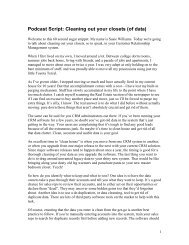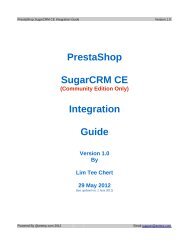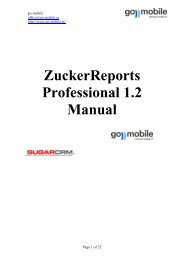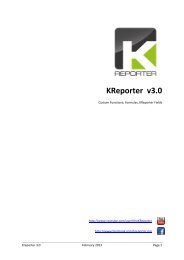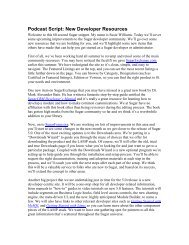Sugar Community Edition Installation and ... - SugarForge
Sugar Community Edition Installation and ... - SugarForge
Sugar Community Edition Installation and ... - SugarForge
Create successful ePaper yourself
Turn your PDF publications into a flip-book with our unique Google optimized e-Paper software.
Developer Toolsassociated with many accounts. The Accounts Detail View will display a Bugssub-panel. Similarly, the Bugs Detail View will display an Accounts sub-panel.The type of relationship that you can create depends on your choice of primary <strong>and</strong>related modules. This is because only a module with sub-panels can have a one-tomanyor a many-to-many relationship with another module. A sub-panel is needed toshow all the related records from the other module.For example, with Accounts as the primary module <strong>and</strong> Knowledge Base as therelated module, you can create only a one-to-one relationship between them. This isbecause Knowledge Base lacks a sub-panel <strong>and</strong>, therefore, Accounts cannot displayrelated records from Knowledge Base. However, if Knowledge Base is the primarymodule <strong>and</strong> Accounts is the related module, you can create a one-to-many relationshipbetween them because Accounts has sub-panels <strong>and</strong>, therefore, Knowledge Base c<strong>and</strong>isplay related records from Accounts.If you are creating a relationship between a custom module <strong>and</strong> a <strong>Sugar</strong> module, thenyou can choose any relationship type because all custom module types include at leastone sub-panel.Sub-panel Types. <strong>Sugar</strong> provides many sub-panel types for your use. When youcreate a relationship that involves sub-panels, <strong>Sugar</strong> displays all sub-panel typesavailable for that module for your selection. A sub-panel can display different sets offields depending on the primary module to which it is related. For example, there areseveral different types of Contacts sub-panels. The Contacts sub-panel that appearsunder Accounts contains different fields than the Contacts sub-panel that appearsunder Cases.The Default type of sub-panel contains the most commonly used fields in the module.Every module has a Default type that contains a set of fields to display as a sub-panel.Select Default if you want to display the most commonly used fields in the sub-panelin the relationship that you create.For example, if you create a one-to-many type of relationship between Calls <strong>and</strong>Accounts, you can select a sub-panel type for the Accounts sub-panel in the CallsDetail View. To use a sub-panel consisting of the most commonly used fields fromAccounts, select the Default sub-panel type; to use the Accounts sub-panel from theemail’s Detail View, select ForEmails.You can create relationships in Module Builder as well as in Studio. However, thereare some differences, which are noted in the table below:Relationship in Module BuilderYou can create relationships with other <strong>Sugar</strong>modules as well as other modules within anyundeployed package.Relationships in StudioIn Studio, you can create relationships onlybetween deployed modules.<strong>Sugar</strong> <strong>Community</strong> <strong>Edition</strong> <strong>Installation</strong> <strong>and</strong> Administration Guide89








